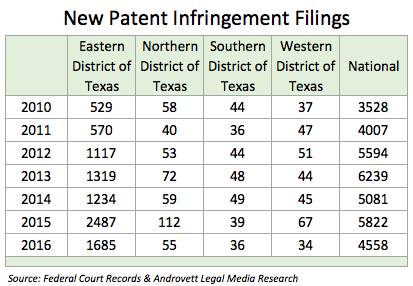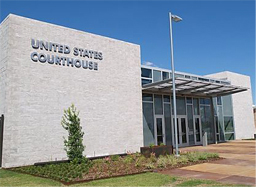© 2017 The Texas Lawbook.
By Mark Curriden
(Jan. 18) – Corporate and individual patent holders filed 33 percent fewer patent infringement complaints in Texas in 2016 than they did the year before.
Despite the dramatic drop, the number of new patent lawsuits filed in the federal courts in the Lone Star state was still the second highest on record, according to new data compiled by Androvett Legal Media.
The data shows that the U.S. District Courts in the Eastern District of Texas, which is by far the most popular jurisdiction for plaintiffs to file their allegations of encroachment on their patents, witnessed its new caseload plunge by one-third last year.

Intellectual property law experts predict the decline in new patent infringement cases will continue during the next year or two.
The Androvett research shows that individuals and businesses sued defendants for alleged patent violations 1,810 times in the state’s four federal district courts in 2016 – down from the record high of 2,704 in 2015. Nationally, new patent infringement filings dropped 22 percent during the past year.
Scott Breedlove, a partner who specializes in intellectual property litigation at Carter Scholer in Dallas, attributes the decline in patent lawsuits to “two three-digit numbers: 101 and 285,” which are sections of federal law governing patents.
“They represent a post-grant administrative patent-invalidation procedure that has real teeth and can give accused infringers confidence that they can defeat an infringement claim without spending millions,” Breedlove said. “This, in turn, can make it harder for plaintiffs to extract an early settlement of any significance and can make patent litigation less attractive to prospective plaintiffs.

The steepest percentage decline in new patent infringement cases came in the U.S. District Courts in Northern District of Texas, which includes Dallas and Fort Worth, where 55 such lawsuits were filed in 2016 – down more than 50 percent from 112 such cases filed in 2015.
But in raw numbers, nothing is comparable to the intellectual property docket in the federal courts in East Texas.
In 2016, there were 1,685 new patent disputes filed in the Eastern District, which includes Marshall, Tyler and Plano. That is a 33 percent decline from the record shattering 2,704 infringement lawsuits submitted in the East Texas federal courts in 2015.
Sharon Israel, a partner specializing in patent litigation at Mayer Brown in Houston, said patent lawsuits spiked in 2012 when Congress passed the America Invests Act, which required most patent holders suing dozens of defendants for infringement to file each complaint as a separate lawsuit instead of jointly in one consolidated complaint.
Gary Sorden, who is the managing principal at the Dallas technology law boutique Klemchuk, also points to the enforcement of recently enacted federal patent procedures for causing the extraordinary spike in new patent filings in November 2015 and the subsequent decline in such lawsuits in the months that followed.
“The federal rules changed in December 2015 that required more stringent pleading standards, and there were hundreds of cases filed before December 2015 in order avoid the higher pleading standards,” Sorden said.
The Androvett research shows that the Eastern District of Texas accounts for 37 percent of all new patent complaints filed in the U.S., which is down from 43 percent last year.
The federal district court with the second most patent filings in 2015 was Delaware with 456 new cases, followed by the California Central District Court with 285 complaints and Northern District Court of Illinois with 242 new patent lawsuits.
“The Eastern District of Texas is still an attractive jurisdiction for patent cases for many reasons,” Israel said. “You have more certainty in the Eastern District about which judge you are going to have, and you know how they approach cases.”
Other legal experts say that efforts by the Congress and federal appellate courts to reign in patent litigation is having its impact.
“The drop in patent filings is not surprising given the general perception that the deck has become stacked against patent owners, and especially against patent owners with limited resources,” said Houston IP lawyer Michael Heim, managing director of Heim Payne & Chorush. “Multiple recent decisions from the U.S. Supreme Court have been adverse to patent owners, and have had a ripple effect on the ability of patent owners to successfully enforce patents.”
Heim points to the U.S. Supreme Court’s decision in Alice Corp. v. CLS Bank, which made it more difficult for software patents to survive validity challenges.
“At the same time, the cost of patent litigation is spiraling because of the ability of defendants to file multiple patent challenges at the U.S. Patent & Trademark Office as part of the Inter Partes Review (IPR) proceedings established by the America Invents Act,” Heim said. “That effectively means that a patent owner must effectively win twice on validity issues – both in litigation and in parallel proceedings before the USPTO, which uses a greatly reduced standard for challenging patents and is generally viewed as a very hostile forum.
“An individual or small business owner rarely will have sufficient funds to embark down this path, and the potential gains that they face, even if they are successful, may be far less than the costs of the litigation,” he said.
Breedlove agrees that Alice is having an impact. He also points to the Supreme Court’s decision two years ago to loosen the standard for awarding attorney’s fees to defendants in patent cases.
“This is the sort of thing that really makes a plaintiff think twice about pursuing litigation, particularly when the infringement read is weak or the [validity] defense is strong,” Breedlove said.
“[This] tool … allowed my client to secure a voluntary dismissal by the plaintiff on the day the plaintiff’s infringement contentions were due,” he said. “It changes the calculus when the plaintiff’s ‘What have I got to lose?’ question is no longer rhetorical.”
Breedlove and others predict that the dip in patent lawsuits will continue into 2017, led by a decline in assertions by high-volume plaintiffs.
 In addition, legal experts point out that jury verdicts favoring the defendants have become much more commonplace in Marshall, Tyler and Texarkana than they used to be.
In addition, legal experts point out that jury verdicts favoring the defendants have become much more commonplace in Marshall, Tyler and Texarkana than they used to be.
“I believe that defendants are getting better at presenting invalidity cases to a jury,” said Sorden. “In the past, presenting invalidity to a jury was an uphill battle but it seems that most of the wins in the Eastern District have been on invalidity … So it leads to the conclusion that defendants have honed in on trying these cases effectively to a jury.
“In addition, the tools available to defendants for locating prior art that would invalidate a patent-in-suit have substantially improved recently and thus, the quality of prior art used in a case related to invalidity may have improved,” he said.
Sorden and the other lawyers also point to the Supreme Court’s decision to hear arguments in In re TC Heartland, which revisits the question of jurisdiction.
“The trend in filings in the EDTX will be tied directly to the outcome of the In re TC Heartland case,” Sorden said. “As the law stands now, plaintiffs can file in EDTX without concerns that venue is improper.
“However, if the Supreme Court mandates that a patent case must be filed where a defendant has a principal place of business, then cases in EDTX will substantially decrease as most of the defendants in EDTX patent cases do not have a principal place of business in EDTX,” he said.
© 2017 The Texas Lawbook. Content of The Texas Lawbook is controlled and protected by specific licensing agreements with our subscribers and under federal copyright laws. Any distribution of this content without the consent of The Texas Lawbook is prohibited.
If you see any inaccuracy in any article in The Texas Lawbook, please contact us. Our goal is content that is 100% true and accurate. Thank you.
